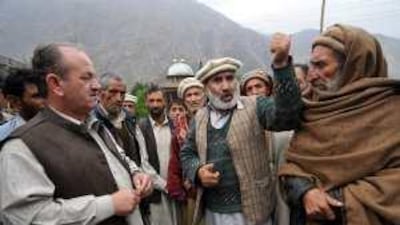GILGIT // Officials in a mountainous northern region of Pakistan are preparing for potential mass flooding, as a lake that was created by a recent landslide threatens to burst its banks and deluge nearby villages. Experts and some officials have accused the government of ignoring the possibility of a catastrophe and said some of the safety measures being taken are in fact adding to the danger.
Authorities say up to 36 villages in the Hunza valley, 1,300km north of Islamabad and home to around 13,000 people, could be affected and are in the process of setting up nine relief centres stockpiled with food and medicine as well as shelters in anticipation of flooding. Sirens are also in place to alert people to danger. Residents in the valley said they have been ordered to evacuate to government schools and clinics. However, on Thursday, there was a confrontation between a district administration official and residents of Juttal village. The official and residents were arguing over the suitability of the evacuation sites, because of their small size.
The official also asked the residents to point out a possible storage site for food and medicines, demonstrating preparations were still in initial stages. Residents gathered at a tea shop in Juglot Guroo, another village, said they had received no warnings and were angry at the lack of information. More than 17,000 residents living close to the river have already been ordered to evacuate to higher ground by Thursday, based on recommendations by a state engineering consultancy, Nespak.
Gen Shahid Niaz, the head of the army's engineers, the Frontier Works Organisation, said they are two weeks from completing a spillway that should divert much of the water back from the lake to the river, mitigating the worst of any flooding. "I can say with an amount of certainty that this dam will not burst as we have reduced the hazard by creating a 350-metre long, 60-metre wide spillway," he told Agence France-Presse this week.
While he said the water would begin draining into the spillway between May 20-30, long before any flooding is expected, he did acknowledge that "some 30 to 36 villages will be affected". However, Asif Balal Lodhi, the home secretary of the Gilgit-Baltistan region, said in an interview that the excavation has stopped because experts had advised that any further excavation of the slipway, beyond the 25-metre depth it has already reached, would further destabilise the dam and could cause its collapse.
In March, Nespak had initially estimated a full collapse could result in flash floods as high as 60 to 70 metres, but changed the worst-case scenario estimate to 30 metres after a detailed study. The lake was created on January 4 by a landslide that bisected the Hunza river, cutting off an upstream part of the waterway and forming a massive artificial lake some 20km long, 300-metres wide and 70-metres deep. The landslide killed four people and left about 25,000 people stranded.
The lake has already submerged three villages, part of the area's administrative centre at Gulmit, and a 15km stretch of the Karakorum Highway, a 1,300km road that links the Gilgit-Baltistan region, of which Hunza is part, to the rest of Pakistan. The highway is also Pakistan's only road to China, its crucial geopolitical ally. Fed by six glacial streams from the Karakorum mountain range, the lake continues to grow in volume, putting pressure on the already unstable mass of earth left behind by the landslide that is keeping it dammed in.
International experts who visited the site and submitted reports to the Pakistani government in March, concluded that the chances of the landslide dam surviving the advent of summer in May - and a greatly accelerated glacial melt that would grow the lake further - had significantly decreased. "The sinkholes are a clear indication that the core of the dam is eroding, which reduces the likelihood of its surviving the summer flood," David Petley, A professor of hazard and risk at Durham University in Britain, said at the time. "Not good it all."
Prof Petley, along with Alessandro Palmeri, a structural engineer with the World Bank, said that while a full dam collapse was unlikely, it was still essential for the government to prepare for the worst. Based on the recommendations of Nespak and the international experts, Hameed-ullah Jan Afridi, the federal minister for environment, called for the urgent formulation of evacuation and relief plans in March.
But the concerns about a disaster shared by he and Mr Lodhi have been dismissed by a number of ministers, along with Gen Niaz of the Frontier Works Organisation, and local officials in Gilgit-Baltistan region. Indeed, it was not until last week, following a tour of the affected area by Gen Pervez Ashfaq Kayani, Pakistan's army chief, that the federal government developed a sense of urgency about the situation in Hunza and enacted the relief and evacuation measures taken in recent days.
However, the international experts are concerned that, in the unlikely event of a monster flood-wave, Pakistan's preparations for the worst are based on the wrong assumptions. "The models suggest that a wave higher than 30 metres is possible, and historic evidence is that floods along this valley do not follow standard attenuation relationship," Prof Petley said on Thursday. "It is a shame if they (the Pakistani authorities) are just setting this aside; let's hope they are right."
thussain@thenational.ae

